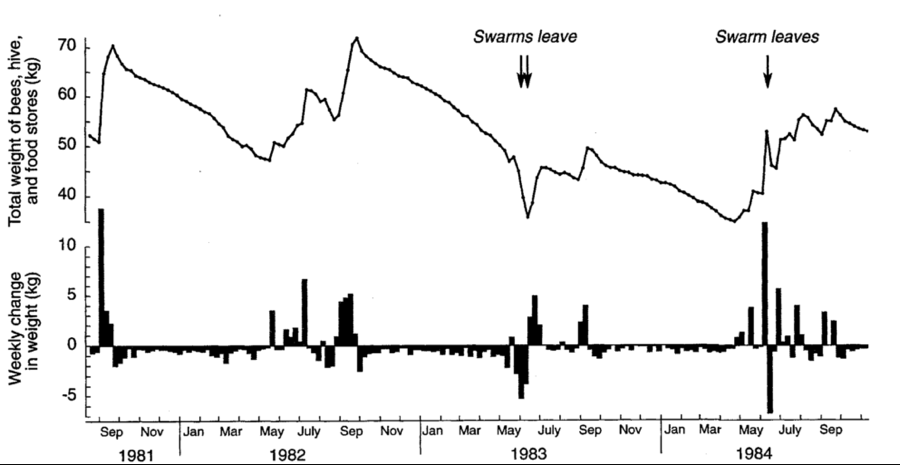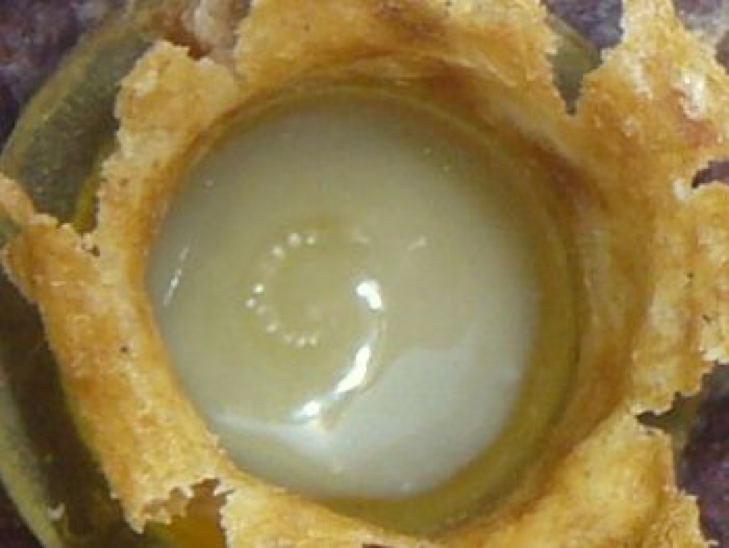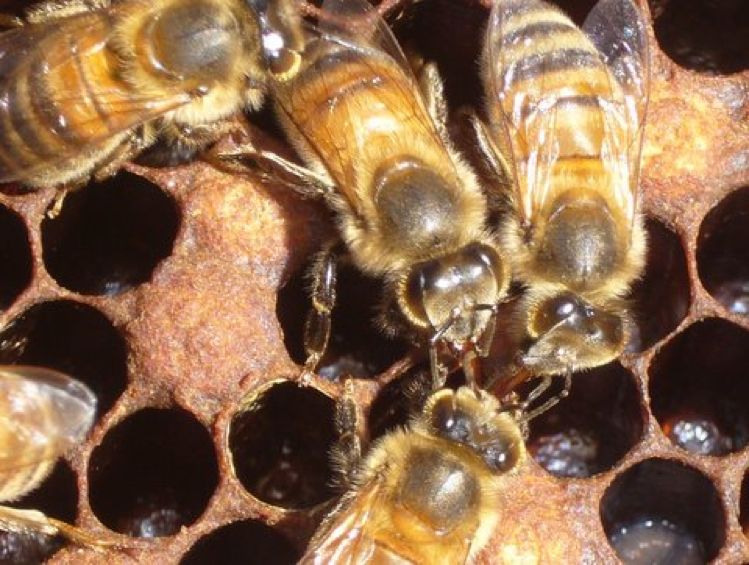The Economy of the Hive – Part 2
March 19, 2011
The Economy of the Hive—Part 2
Randy Oliver
ScientificBeekeeping.com
First published in American Bee Journal February 2010
Last month I described the functions of the main players in the hive economy—the queen, the nurse bees, the foragers, and the “resting” bees. Now let’s look at the main driver for the bee economy—the supply of food.
The honey bee economy is based upon the gathering and consumption of four resources (nectar, pollen, propolis, and water), the processing, distribution, and consumption of those resources, and the production of waxen comb, honey, beebread, and bees. The smooth working of the economy is governed by the exchange of information between the bees performing the various tasks.
The bee economy booms each spring, and contracts each winter. Following a good year, it can celebrate by throwing off a swarm the next spring. However, in poor forage years, or when in battle with parasites, the colony will go to extreme measures to try to survive. Even in an average year, the colony must constantly adjust to changing conditions. I asked Dr. Tom Seeley if I could use one of his graphs to illustrate the erratic input of nectar flow to the hive economy, and the effect of its major output–swarms:
 |
A three-year record of weekly weighings of a honey bee colony. Bars above the line indicate that the colony gained weight that week; bars below indicate that the colony lost weight. Note just how few weeks in any year that a colony actually gains weight! Courtesy Dr. Thomas D. Seeley (1995) The Wisdom of the Hive.
The graph above clearly shows just how tenuous is the existence a bee colony. There are only a few weeks out of an entire year in which the colony actually gains weight! Note how quickly the colony regains its population after swarming, but also the loss of weight that week. In contrast to the timing of the “flows” in Seeley’s East Coast location, in my arid-summer California locations the colony puts away the bulk of its winter stores in the few weeks from mid May until the end of June—the rest of the year it is largely in survival mode, due to the limitation of resources by cold, rain, or late summer drought. And to add further challenge, during the middle of that short productive period it must deal with the toxicity of the pollen and nectar of the buckeye tree! In order to conserve resources in dry years, some colonies (especially the Russian stocks) go into a broodless resting state in late summer.
Practical Tip: Make a rough graph similar to the above for your area. Any portions (other than when colonies are in winter cluster) that the bars dip down for more than a week or so might be appropriate times to feed syrup and/or pollen supplement—especially if there is poor forage prior to the main flow.
The bases of any economy are food and energy. For bees, “food” mainly means pollen. Energy comes from the sugars in nectar, which bees have the amazing ability to convert into stable honey, which they store for lean times (both for metabolic energy and as fuel to heat their house). Because nectar intake in excess of the colony’s needs happens so rarely, whenever an easily gathered surplus becomes available (a “honeyflow”), the colony is primed to drop everything else and focus on nectar collection and processing.
During strong flows, the colony will crowd the broodnest with nectar, and all hands (depending upon their abilities) get involved in the collecting, processing, comb building, and storage of the precious liquid. The nectar and honey aspect of the bee economy is generally well understood by beekeepers, so I am not going to elaborate on it further.
Of much greater import to the bee economy is the main food: pollen. Pollen is the source of precious protein (necessary to build the bees’ bodies), of lipids, sterols, vitamins, and minerals. And whatever necessary nutrients are not found in raw pollen, the bees, with the help of their symbiotic microbiota, create in the alchemy of the fermentation of beebread.
But pollen alone is too bulky and crude a food for the ravenous hunger of the queen, who may lay nearly her body weight in eggs each day. She could not possibly eat and digest enough pollen daily to fulfill that task! So she depends upon a royal diet of jelly fed to her, predigested by the nurse bees.
Nurse bees must supply the hungry brood with frequent feedings of protein-rich jelly. In a well-nourished colony, a fecund queen can lay enough eggs to fill the equivalent of a side of a deep comb every day.
An even larger appetite is that of the voracious brood, each larva of which must eat enough to increase its weight by a factor of about 1700 in a little over 5 days (that would be like a 7 lb human baby growing to the size of a 6-ton elephant in 5 days!). And if that weren’t enough, drones and foragers eat little pollen—so they also depend upon the nurse bees to feed them!
As far as I can tell from the literature, it appears that neither the queen, the larvae, drones, nor older workers digest pollen to any extent themselves, but are all dependent upon nurse bees (from about 3-15 days old) to feed them jelly (the adults are able to serve themselves nectar and honey). Indeed, the foragers of a colony sometimes require as much jelly as do the brood (Schmickl and Crailsheim 2004).
Practical Tip: Lack of pollen indirectly affects the health of the workers as well as restricting brood production.
Practical Tip for queen producers: drones need to be fed with plenty of jelly for several days after emergence in order to develop their flight muscles and mucus glands. Queens also need to be “fattened” after emergence in the nucs. Queens mated in protein-hungry nucs, or those lacking young nurse bees may fail prematurely (Dr. Denis Anderson, per comm)!
This conversion of pollen into protein-rich jelly is really the essence of bee economics. The jelly is the true currency of colony wealth. When pollen is abundant, colonies are awash in jelly, and vigorously rear brood, produce drones (any time of year), and may swarm if the season is right. When pollen is temporarily scarce, the nurse bees may practice “deficit spending,” and actually borrow protein reserves from their own bodies in order to feed the queen and brood.
A queen larva afloat in a deep pool of royal jelly. Bees do not defecate as larvae, so can thus rest directly in their food, breathing through the exposed spiracles on the upper side of their body. The jelly is a “perfect food”–no other source of nutrition is necessary!
Should protein become even scarcer, the nurses will cannibalize drone brood, eggs, and young worker brood (in which they have invested the least resources), digest out the protein, and recycle it back into jelly. And in extreme circumstances, the nurses will hoard the remaining protein in their bodies, and become the aforementioned diutinus, or “winter” bees.
Practical Tip: Workers which develop as larvae during pollen dearths may have food withheld, and thus be compromised in later life—beekeepers should be aware of this delayed effect.
I strongly recommend that the serious beekeeper read about the protein dynamics of the hive in a fascinating review by Schmickl and Crailsheim (2004), which is a free download. The authors detail how bees use jelly to distribute and share (or restrict), protein reserves in a colony through the process of trophallaxis (the exchange of food from bee to bee). This trophallactic sharing of food is the basis of the social structure of the colony. Indeed, newly-emerged bees beg for an inoculum of jelly and beneficial bacteria from nurse bees in order to prime their sterile gut.
So what about this vital (and aptly named “royal”) jelly? It apparently evolved from the saliva of the bees’ meat-eating ancestors. By converting the essential nutrients of bulky pollen into a concentrated jelly, the nurse bee is able to feed a purified, sterilized, and highly digestible food to the queen and larvae, thus eliminating the huge amount of poop that would otherwise be discharged inside the hive by them (Webster and Peng 2002). So perfect is jelly as a food, the queen’s excrement looks like water!
Jelly is produced by the hypopharyngeal glands in the bees’ heads–the protein mobilized via their “blood” from stores of vitellogenin in the fat bodies and ovaries. Vitellogenin (vitello = yolk; gen = producing) is a universal egg yolk precursor that has been adopted by the functionally sterile female worker bees to be used as a storage protein.
Equally important, Drs. Page and Amdam have published several papers on how vitellogenin can actually change the physiology, behavior, longevity, and immune function of bees (see my Fat Bees articles). (Beekeepers benefit from the Page lab’s research in gerontology (the study of aging), for which bees have become a model organism. It’s easier to find funding if you have a chance at discovering a human “fountain of youth”). A recent paper (Li 2009) demonstrated that vitellogenin also kills bacteria—which may help to explain why low-vitellogenin bees are more susceptible to disease.
Since the economy of the hive is fundamentally based upon colony nutrition, especially with regard to protein, the main commerce in the hive is that of foodstuffs—nectar, honey, and jelly. (Raw pollen is gathered, prepared, and stored by individual foragers, and not much “traded.”) If we think of honey as being the wealth and savings of a colony, then jelly is the lifeblood, and the measure of its immediate financial state.
The immediacy is due to the fact that relatively little pollen is stored in the colony at any time, so the bulk of protein “savings” are the reserves within the bees’ bodies. (However, Otis (2004) did find that stored beebread was necessary for winter brood rearing in Canada prior to natural pollen flows).
Practical Tip: When the colony is actively rearing brood, all the pollen reserves can be completely used up during a few days of rain. At that point, the nurse bees must dig into their body reserves, and brood rearing is constrained. In order to prevent a loss of “momentum” in colony buildup, the beekeeper may wish to supply pollen supplement during inclement weather.
Protein is transferred throughout the colony via trophallaxis (food sharing). Only nurse bees produce jelly, and feed it to the queen and drones, the brood, and the very young and older workers. This “communion” allows the communication of the current nutritive state to all members of the colony.
Therefore, it is not surprising that the main means of communication within the hive about the state of its economy is by the trophallactic sharing of nectar/honey and jelly. Thus, jelly is not only nutriment, but also functions as a currency, medicine, a means of communication, a reservoir of wealth, and as the main sustenance of the queen, brood, and foragers (along with nectar). The health and vigor of the bee economy is predicated on the abundance and flow of jelly from the nurses to the rest of the bees in the hive.
The sharing of royal jelly is the communion that holds the bee society together. It is the means by which a colony “thinks,” monitors its nutritional state, and regulates its homeostasis. To the bee, jelly is the fountain of youthfulness, health, and vitality. Understand the significance of jelly, and you will understand the soul of the bee colony.
Schmickl and Crailsheim point out that the center of colony communication is the brood nest. The brood nest is the “trading floor” for the bee economy, where exchanges of protein, sugars, and pheromones are made. And centered in the brood nest is the heart of the colony—the queen. The brood nest functions as the “blackboard” for the posting the current status of the economy, and as a record of what has transpired over the previous weeks.
Practical Tip: A thoughtful inspection of the broodnest provides the beekeeper with a record of what has transpired in the hive’s economy over the previous weeks, a report on its current status, and a prediction of its future.
In my next article I will discuss colony communication and sharing of the wealth.
Not Rocket Science
Beekeeping has a long history of challenges, die offs, and debate about management practices. We now have at our disposal fantastic advances in scientific tools—polymerase chain reaction (PCR) and gene sequencing that can dissect the genome, pesticide testing to the parts per trillion, data-crunching computers and statistics that can make your head spin.
But when it comes down to applications that the beekeeper can actually practice in the field, the science is generally pretty simple, and often initiated by beekeepers themselves. There are a lot of ingenious beekeepers in the world, and kind of like the proverbial monkeys on typewriters, they are bound to figure things out by plain trial and error. Afterward, scientists can enter to set up trials to collect the data necessary to separate effective treatments from chance, and to use laboratory instrumentation to determine the molecular or physical mechanisms involved.
My readers certainly see the great appreciation and respect that I have for the world’s bee research scientists. However, beekeepers often have practical questions that could be answered by simple, field trials and data collection. Unfortunately, many of these small research opportunities simply drop between the cracks, either because the funding organizations can’t respond quickly enough, or because such research doesn’t look “sexy” enough on a postdoc’s resume.
There is no reason that any diligent beekeeper can’t ask a local community college professor to help him or her to set up a controlled (having a control group) trial using the scientific method. Luckily, much of this research would involve nothing more than equalizing test colonies, applying treatments or biotechnical methods, and then counting mites or spores, weighing hives, visually measuring “frame strength,” or recording survival. Valuable information often could often be obtained by any small-scale beekeeper willing to enroll a couple dozen colonies in a trial.
I always have more trials in mind than I have the time or means to perform, so I’m asking for help. I’d be glad to offer assistance in experimental design to any beekeeper or club willing to diligently collect data, and I will help you to write up the results for the benefit of all. Alternatively, any group that wants to contribute some money for practical bee research can let me know, and if I have, or hear of, a small project needing funding (usually in the few hundred to few thousand dollar range), I may approach you to see if you wish to support it.
I truly feel that many of our challenges in beekeeping can be solved by simple management practices based upon the results of small, practical research projects. Beekeepers have a long history of figuring out ways to survive every new problem. I’m suggesting that beekeepers rise to the occasion, and add to the body of beekeeping knowledge by engaging in citizen research, and sharing the results for everyone’s benefit! Let me know if you are interested.
Acknowledgments
As always, I am deeply indebted to my collaborator in research, Peter Loring Borst. I also appreciate the generosity of Drs. Zachary Huang, Rob Page, Gro Amdam, Heather Mattila, and Tom Seeley, who took the time to answer my questions and share unpublished research.
References
Li, Z, et al (2009) Vitellogenin is a cidal factor capable of killing bacteria via interaction with lipopolysaccharide and lipoteichoic acid. Molecular Immunology 46: 3232–3239.
Mattila HR and GW Otis (2007) Dwindling pollen resources trigger the transition to broodless populations of long-lived honeybees each autumn ECOLOGICAL ENTOMOLOGY 32 (5): 496-505.
Nelson CM, Ihle KE, Fondrk MK, Page RE Jr, Amdam GV (2007) The Gene vitellogenin Has Multiple Coordinating Effects on Social Organization . PLoS Biol 5(3): e62.
Otis, GW, DE Wheeler, N Buck, HR Mattila (2004) Storage proteins in winter honey bees. Apiacata 38: 352-357.
Schmickl, K & K Crailsheim (2004) Inner nest homeostasis in a changing environment with special emphasis on honey bee brood nursing and pollen supply. Apidologie 35: 249–263 This is a “must read” article for the serious beekeeper, which can be downloaded free at http://www.apidologie.org
Seeley, T.D. (1995) The Wisdom of the Hive. Harvard Univ. Press
Webster, T and Y-S Peng (2002) The evolution of food-producing glands in eusocial bees (Apoidea, Hymenoptera). Journal of Evolutionary Biology 1(2): 165-176.







